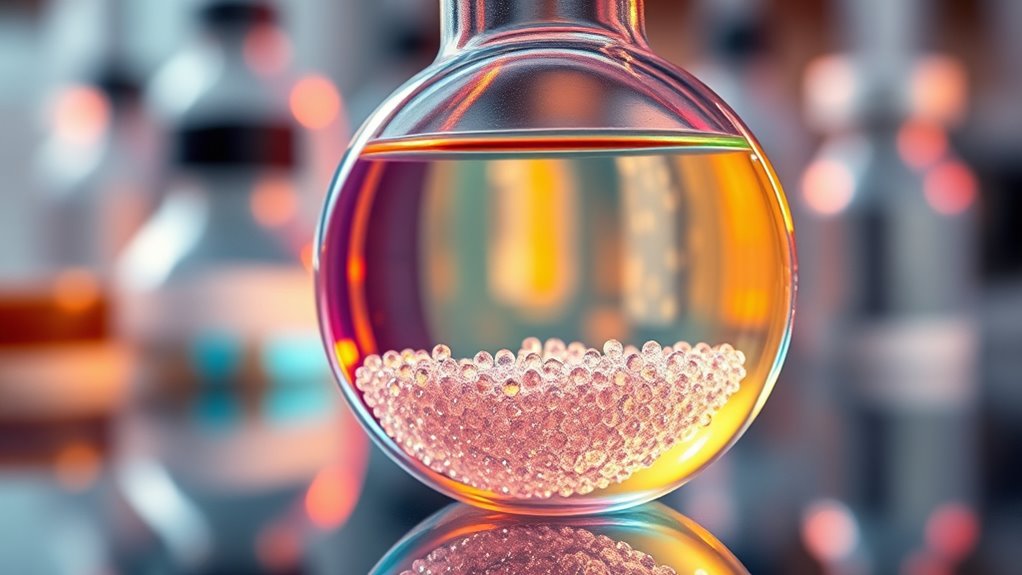Electrolyte additives are tiny chemical tweaks that can dramatically extend your battery’s lifespan and improve performance. By enhancing stability, safety, and resistance to degradation, these small adjustments help your batteries last longer and operate more reliably over numerous cycles. Compatibility is key; the right additive works harmoniously with your electrolyte and electrodes, preventing side reactions and ensuring consistent power. Keep exploring to discover how selecting the proper additives can release even greater battery durability.
Key Takeaways
- Small chemical tweaks with electrolyte additives can significantly enhance battery stability and extend lifespan.
- Compatibility between additives and electrolyte components is crucial to prevent side reactions and degradation.
- Proper additive selection improves SEI layer formation, boosting long-term battery performance.
- Tailoring additives to specific applications ensures better safety, cycle life, and overall durability.
- Strategic electrolyte modifications lead to substantial lifespan gains with minimal chemical adjustments.

Electrolyte additives play a critical role in enhancing the performance, safety, and lifespan of batteries. These tiny chemical tweaks can markedly influence how well your battery functions over time. When you introduce an additive, you’re fundamentally fine-tuning the electrolyte to improve specific characteristics, such as battery stability. A stable battery resists voltage fluctuations and reduces capacity fade, making it more reliable during repeated charge and discharge cycles. But to achieve this, understanding additive compatibility is essential. Not all additives work well with every electrolyte or electrode material, so selecting the right one guarantees you don’t inadvertently cause side reactions or degrade other components.
Your choice of electrolyte additives should be guided by compatibility with the existing battery chemistry. If an additive isn’t compatible, it might form unwanted byproducts or interfere with ion transport, which could jeopardize battery stability. When you focus on additive compatibility, you help maintain a harmonious environment inside the cell, preventing issues like gas formation, electrode degradation, or short circuits. This compatibility guarantees the additive enhances, rather than undermines, the core functions of the battery. For example, certain additives are tailored to strengthen the SEI layer on lithium-ion anodes, boosting stability without compromising capacity. Others may improve electrolyte conductivity or suppress unwanted side reactions, all of which extend the battery’s operational life.
Choosing compatible additives ensures a stable, safe, and efficient battery environment.
Additionally, selecting the right electrolyte additives involves understanding their impact on juice detoxification and how they influence the overall chemical environment within the battery. It’s indispensable to tailor your electrolyte formulation to match the specific demands of your application. If you’re designing a high-performance electric vehicle battery, the additives you choose should prioritize long-term stability and safety. Conversely, for consumer electronics, quick charge capabilities and cycle life might be more important. By understanding the delicate balance of additive compatibility, you can select compounds that seamlessly integrate into your electrolyte system, providing steady performance over thousands of cycles.
Incorporating the right electrolyte additives isn’t just about boosting initial performance; it’s about creating a resilient battery that maintains its efficiency over time. When you pay close attention to how these additives interact with your electrolyte and electrode materials, you notably reduce the risks of degradation and failure. This careful selection process ensures that your battery remains stable, safe, and capable of delivering consistent power, ultimately leading to longer lifespan and better value for your investment. Fundamentally, small chemical adjustments, thoughtfully made, can lead to substantial gains in battery durability and performance.
Frequently Asked Questions
Are Electrolyte Additives Safe for All Battery Types?
When considering electrolyte additives, you might wonder if they’re safe for all battery types. The truth is, additive safety depends on battery compatibility; not every additive works well with every battery chemistry. You should check manufacturer guidelines and verify the additive is designed for your specific battery type. Using incompatible additives can cause damage or safety issues, so always prioritize proper compatibility to keep your batteries safe and effective.
How Long Do Electrolyte Additives Typically Last?
You wonder how long electrolyte additives last, and the answer varies. Additive longevity depends on factors like storage conditions, chemical stability, and usage frequency. Typically, they retain effectiveness for several months to a few years, with shelf life playing a vital role. Proper storage in cool, dry environments helps maximize their lifespan. Regularly check expiration dates and follow manufacturer guidelines to guarantee peak performance and avoid premature degradation.
Can Electrolyte Additives Be Used in Existing Batteries?
You can often use electrolyte additives in existing batteries, but you need to consider additive compatibility to guarantee they won’t negatively affect performance. It’s essential to evaluate manufacturing implications since some additives may require adjustments in the production process. If properly integrated, these tweaks can enhance battery lifespan without major redesigns. Always test thoroughly before deploying additives in current batteries to avoid unforeseen issues and maximize benefits.
Do Electrolyte Additives Impact Recyclability?
Think of electrolyte additives as modern-day alchemy, transforming battery performance. They can impact recyclability by introducing recycling challenges, especially if they aren’t compatible with existing processes. Additive compatibility plays a vital role in ensuring smooth recycling. If additives aren’t well-matched, they might hinder efficient material recovery, making recycling more complex. So, while these tweaks boost lifespan, they can also complicate recycling efforts if not carefully managed.
Are There Environmental Concerns With Electrolyte Additives?
You might wonder if electrolyte additives raise environmental impact or sustainability concerns. While they can improve battery performance, some additives contain materials that pose environmental risks during manufacturing or disposal. It’s important to take into account the sustainability of these components and their life cycle. Overall, balancing performance with environmental impact ensures that electrolyte additives contribute positively to sustainable battery development without exacerbating environmental concerns.
Conclusion
By adding small tweaks to electrolytes, you unseal bigger benefits—longer battery life, enhanced stability, and improved performance. These tiny changes act like secret keys, opening doors to lasting power and reliability. With each additive, you’re shaping a future where batteries endure, perform, and excel. Embrace these simple tweaks, and watch your energy storage transform—fueling your devices, empowering your life, and lighting the way toward smarter, longer-lasting energy solutions.










